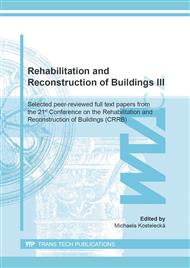[1]
G. Khoury: Effect of fire on concrete and concrete structures, Progress in Structural Engineering and Materials. Vol. 2 (2000), Issue 4, pp.429-447.
DOI: 10.1002/pse.51
Google Scholar
[2]
M. Colombo and R. Felicetti: New NDT techniques for the assessment of fire-damaged concrete structures, Fire Safety Journal, Vol. 42 (2007), Issues 6–7, pp.461-472.
DOI: 10.1016/j.firesaf.2006.09.002
Google Scholar
[3]
C. Payan, V. Garnier, and J. Moysan: Applying nonlinear resonant ultrasound spectroscopy to improving thermal damage assessment in concrete, The Journal of the Acoustical Society of America, Vol. 121 (2007), pp.125-130.
DOI: 10.1121/1.2710745
Google Scholar
[4]
K. Van Den Abeele, P.A. Johnson and A. Sutin: Nonlinear Elastic Wave Spectroscopy (NEWS) Techniques to Discern Material Damage, Part I: Nonlinear Wave Modulation Spectroscopy (NWMS), Research in Nondestructive Evaluation, Vol. 12(2000), Issue 1, pp.17-30.
DOI: 10.1080/09349840009409646
Google Scholar
[5]
S. Majhi, A. Mukherjee, N. V. George and B. Uy: Corrosion detection in steel bar: A time-frequency approach, NDT and E International, Vol. 107 (2019), 102150.
DOI: 10.1016/j.ndteint.2019.102150
Google Scholar
[6]
K. Timčaková-Samarkova, M. Matysík and Z. Chobola: Possibilities of NUS and impact-echo methods for monitoring steel corrosion in concrete, Materiali in Tehnologije, Vol. 50 (2016), Issue 4, pp.565-570.
DOI: 10.17222/mit.2015.149
Google Scholar
[7]
M.Á. Climent, M. Miró, J. Carbajo, P. Poveda, G. de Vera and J. Ramis: Use of non-linear ultrasonic techniques to detect cracks due to steel corrosion in reinforced concrete structures Materials, Vol. 12 (2019), Issue 5, 813.
DOI: 10.3390/ma12050813
Google Scholar
[8]
M. Matysik, M. Korenska and I. Plskova: NDT of freeze-thaw damaged concrete specimens by nonlinear acoustic spectroscopy method, 10th International Conference of the Slovenian Society for Non-Destructive Testing: Application of Contemporary Non-Destructive Testing in Engineering, 2009, pp.317-323.
DOI: 10.5507/tots.2009.024
Google Scholar
[9]
K. Van Den Abeele, J. Carmeliet, J. TenCate, and P. A. Johnson: Nonlinear elastic wave spectroscopy NEWS techniques to discern material damage, Part II: Single-mode nonlinear resonance acoustic spectroscopy, Research in Nondestructive Evaluation, Vol. 12 (2000), Issue 1, pp.34-42.
DOI: 10.1080/09349840009409647
Google Scholar
[10]
T. Húlan, M. Knapek, P. Minárik, S. Csáki, T. Kaljuvee, and M. Uibu: Assessing the frost resistance of illite-based ceramics through the resonant frequency of free vibration and internal damping, AIP Conference Proceedings, 1866 (2017).
DOI: 10.1063/1.4994495
Google Scholar
[11]
G. S. Miljković, I. S. Stojković and D. B. Denić: Generation and application of pseudorandom binary sequences using virtual instrumentation, Facta universitatis - Series: mathematics and informatics, Vol. 10 (2011), pp.51-58.
Google Scholar
[12]
R. Štoudek, T. Trčka, M. Matysík, T. Vymazal and I. Plšková: Acoustic and Electromagnetic Emission of Lightweight Concrete with Polypropylene Fibers, Materiali in tehnologije, Vol. 50 (2016), Issue 4, pp.547-552.
DOI: 10.17222/mit.2015.138
Google Scholar
[13]
S. Engelberg and H. Benjamin: Pseudorandom sequences and the measurement of the frequency response, IEEE Instrumentation & Measurement Magazine, Vol. 8 (2005), Issue 1. pp.54-59.
DOI: 10.1109/mim.2005.8456673
Google Scholar
[14]
M. Matysík, L. Topolář, P. Daněk, T. Vymazal and I. Plšková: The Effect of Concrete Quality on the Acoustic Emission Parameters During Three-point Bending Fracture Test, Advanced Materials Research, Vol. 897 (2014), pp.149-152.
DOI: 10.4028/www.scientific.net/amr.897.149
Google Scholar
[15]
C. Ferreira, L. C. Neves, A. Silva and J. de Brito: Stochastic maintenance models for ceramic claddings, Structure and Infrastructure Engineering, 2019, in press,.
DOI: 10.1080/15732479.2019.1652657
Google Scholar


